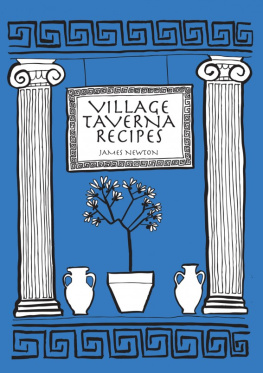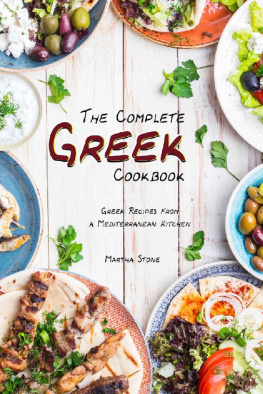James Newton - Greek Cookbook Village Taverna Recipes
Here you can read online James Newton - Greek Cookbook Village Taverna Recipes full text of the book (entire story) in english for free. Download pdf and epub, get meaning, cover and reviews about this ebook. year: 2012, genre: Home and family. Description of the work, (preface) as well as reviews are available. Best literature library LitArk.com created for fans of good reading and offers a wide selection of genres:
Romance novel
Science fiction
Adventure
Detective
Science
History
Home and family
Prose
Art
Politics
Computer
Non-fiction
Religion
Business
Children
Humor
Choose a favorite category and find really read worthwhile books. Enjoy immersion in the world of imagination, feel the emotions of the characters or learn something new for yourself, make an fascinating discovery.
- Book:Greek Cookbook Village Taverna Recipes
- Author:
- Genre:
- Year:2012
- Rating:5 / 5
- Favourites:Add to favourites
- Your mark:
- 100
- 1
- 2
- 3
- 4
- 5
Greek Cookbook Village Taverna Recipes: summary, description and annotation
We offer to read an annotation, description, summary or preface (depends on what the author of the book "Greek Cookbook Village Taverna Recipes" wrote himself). If you haven't found the necessary information about the book — write in the comments, we will try to find it.
Greek Cookbook Village Taverna Recipes — read online for free the complete book (whole text) full work
Below is the text of the book, divided by pages. System saving the place of the last page read, allows you to conveniently read the book "Greek Cookbook Village Taverna Recipes" online for free, without having to search again every time where you left off. Put a bookmark, and you can go to the page where you finished reading at any time.
Font size:
Interval:
Bookmark:
Village Taverna Recipes James Newton SmashwordsEdition 2011-12 Springwoodemedia All rightsreserved Contents About Greece Greek Cuisine Greek Cuisine Recipes Appetizers Tzatziki - Yoghurtdip Taramosalata Spicy CheeseSpread Meatballs Saganaki Salads Auberginesalad Bean salad Beetroot salad Cabbage & carrotsalad Greek salad Green bean & Tuna salad Potato and lettucesalad Spinach and fetalettuce Tomato and cucumbersalad Tomato and Feta cheesesalad Meat Dishes Baked Lamb withOregano Stifado (Beef stew) Baked Rabbit withmushrooms Beef with RedSauce Charcoal lambchops Goat in Clay Pot Grilled PorkChops Hamburger withHerbs Lamb in TomatoSauce Macaroni Baked withMeat Meat and PotatoCasserole Meat Roll Meatballs with CrackedWheat Meatballs with Cumin Moussaka Pork in Red WineSauce Sofrito Sausages with GreenPeppers Souvlaki StuffedAubergines Stuffed Vineleaves Kebab Rice Veal with RedBeans ChickenDishes Chicken Casserole with Lemon Sauce Chicken in TomatoSauce Chicken with RiceCasserole Chicken with Vegetable andMastic Rooster in Red WineSauce Pasta Dishes Baked Macaroni &Bechamel Sauce Greek Spaghetti withShrimps or Prawns Meat and MacaroniPie Pasta withCheese Pastitsada (SpicyBeef) Fish Dishes Bianco Bass from Corfu Cod with AromaticHerbs Cod withCoriander Charcoaled Swordfish withZucchini and Mushrooms Crayfish withLemon Fried Battered Fish withGarlic Sauce Lobster withRice Fried Red Mullet Fried Sardines Fried Squid Sole in Cream and YoghurtSauce Tunafish inHerbs Fried Mussels Shrimps with Garlic andSpring Onions Sweet Dishes Almond Pie Apple Pie BaklavaRolls Easter Cookies Halva About Greece Approximately 16.5 million tourists visitGreece each year, more than the countrys entire population.Tourism constitutes nearly 16% of the Gross Domestic Product(GDP). About 7% of all the marble produced in theworld comes from Greece. The worlds third leading producer ofolives, the Greeks have cultivated olive trees since ancient times.Some olive trees planted in the thirteenth century are stillproducing olives. Greece has zero navigable rivers because ofthe mountainous terrain. Nearly 80% of Greece is mountainous. Thousands of English words come from theGreek language, sometimes via the Roman adaptation into Latin andthen to English.
Common English words from Greek include academy,apology, marathon, siren, alphabet, and typhoon. Greece has more than 2,000 islands, of whichapproximately 170 are populated. Greeces largest island isCrete (3,189 sq. miles) (8,260 sq. km.). Continuously inhabited for over 7,000 years,Athens is one of the oldest cities in Europe.
It is also thebirthplace of democracy, Western philosophy, the Olympic Games,political science, Western literature, historiography, majormathematical principles, and Western theories of tragedy andcomedy. Greece enjoys more than 250 days ofsunshineor 3,000 sunny hoursa year. Currently, Greek men must serve from oneyear to 18 months in any branch of the armed forces. The governmentspends 6% of the annual Gross Domestic Product (GDP) on themilitary. Greece is the leading producer of seasponges. Greek ships make up 70% of the EuropeanUnions total merchant fleet.
According to Greek law, 75% of aships crew must be Greek. Greece has more archaeological museums thanany other country in the world. Retirement homes are rare in Greece.Grandparents usually live with their childrens family until theydie. Most young people live with their families until theymarry. Many Greek structures such asdoors, windowsills, furniture, and church domes are painted aturquoise blue, especially in the Cyclades Islands. It is usedbecause of an ancient belief that this shade of blue keeps evilaway.
They called the color kyanos , which the words cyan and cyanide are derivedfrom. Feta, which is made from goats milk, is theGreeces national cheese. It dates back to the Homeric ages, andthe average per-capita consumption of feta cheese in Greece is thehighest in the world. In Greece, people celebrate the name dayof the saint that bears their name rather than their ownbirthday. Thousands of birds stop in Greeces wetlandson their migrations. As many as 100,000 birds from northern Europeand Asia spend their winters there.
The saying taking the bull by its hornscomes from the Greek myth of Hercules saving Crete from a ragingbull by seizing its horns. The first Olympic Games took place in 776B.C. The first Olympic champion was a Greek cook named Coroebus whowon the sprint race. Greek has been spoken for more than 3,000years, making it one of the oldest languages in Europe. Greeks do not wave with an open hand. Infact, it is considered an insult to show the palm of he hand withthe fingers extended.
Greeks wave with the palm closed. No point in Greece is more than 85 miles(137 kilometers) from water. Greece has about 9,000 miles ofcoastline, the 10th longest in the world. The Greek flag is includes nineblue-and-white horizontal stripes, which some scholars say standfor the nine syllables of the Greek motto Eleftheria iThanatos orFreedom or Death. Blue represents Greeces sea and sky, whilewhite stands for the purity of the struggle of freedom. In theupper left-hand corner is the traditional Greek Orthodoxcross.
Greek Cuisine Greece has an ancient culinary traditiondating back several millennia, and over the centuries Greek cuisinehas evolved and absorbed numerous influences and influenced manycuisines itself. Some dishes can be traced back to ancientGreece: lentil soup, fasolada, retsina (white or ros wine flavoredwith pine resin) and pasteli (candy bar with sesame seeds bakedwith honey); some to the Hellenistic and Roman periods: loukaniko(dried pork sausage); and Byzantium: feta cheese, avgotaraho (curedfish roe) and paximadi (traditional hard bread baked from corn,barley and rye). There are also many ancient and Byzantine dishes,which are no longer, consumed: porridge as the main staple, fishsauce, and salt water mixed into wine. Many dishes are part of the larger traditionof Ottoman cuisine and their names reveal Arabic, Persian orTurkish roots: moussaka, tzatziki, yuvarlakia, keftethes, bourekiand so on. Many dishes names probably entered theGreek vocabulary during Ottoman times, or earlier in contact withthe Persians and the Arabs. Some dishes may be pre-Ottoman, onlytaking Turkish names later; Ash and Dalby, for example, speculatethat grape-leaf dolmathes were made by the early Byzantineperiod.
Greek cuisine is very diverseand although there are many common characteristics amongst theculinary traditions of different regions within the country, thereare also many differences, making it difficult to present a fulllist of representative dishes. For example, the vegetarian dish Chaniotiko Boureki (oven baked slices of potatoes with zucchini,myzithra cheese and mint) is a typical dish in western Crete, inthe region of Chania. A family in Chania may consume this dish 1-2times per week in the summer season. However, it is not cooked inany other region of Greece. Many food items are wrapped in Filopastry, either in bite-size triangles or in large sheets: kotopita(chicken), spanakotyropita (spinach and cheese), chortopita(greens), kreatopita (meat pie, using minced meat), etc. Greek CuisineRecipes Appetizers The most common type of a Greekappetizer would be dips or s preads such as taramosalata (fish roe salad) or melitzanosalata (eggplant salad).
You can dip bread on these kindsof appetizers. Tzatziki - Yoghurtdip INGREDIENTS 1/2kilo strained yoghurt 1 cucumber 4 garlic cloves (more makes it with strongertaste) salt oil vinegar METHOD Grate the garlic and mix itwith salt and vinegar. Peel the cucumber, grate it and squeeze ituntil all its water is removed. Put the yoghurt into a bowl and addthe cucumber into it. Then mix the yoghurt with the mixture ofgrated garlic. Whiz the content until all the ingredients are wellmixed.
Add some oil. Yoghurt dip can be served in a normaltemparature but it is rather prefered cold. Taramosalata INGREDIENTS 125 gr fish roe 4 slices stale bread 1 medium onion (optional) lemon juice parsley 150 gr olive oil METHOD Remove crusts from bread,soak and drain it. Place the fish roe and the onion (chopped) in amixer and beat well. Add gradually the lemon juice, the bread andthe olive oil and continue beating the mixture until it becomessoft and creamy. Serve in a bowl and garnish withparsley.
Next pageFont size:
Interval:
Bookmark:
Similar books «Greek Cookbook Village Taverna Recipes»
Look at similar books to Greek Cookbook Village Taverna Recipes. We have selected literature similar in name and meaning in the hope of providing readers with more options to find new, interesting, not yet read works.
Discussion, reviews of the book Greek Cookbook Village Taverna Recipes and just readers' own opinions. Leave your comments, write what you think about the work, its meaning or the main characters. Specify what exactly you liked and what you didn't like, and why you think so.











